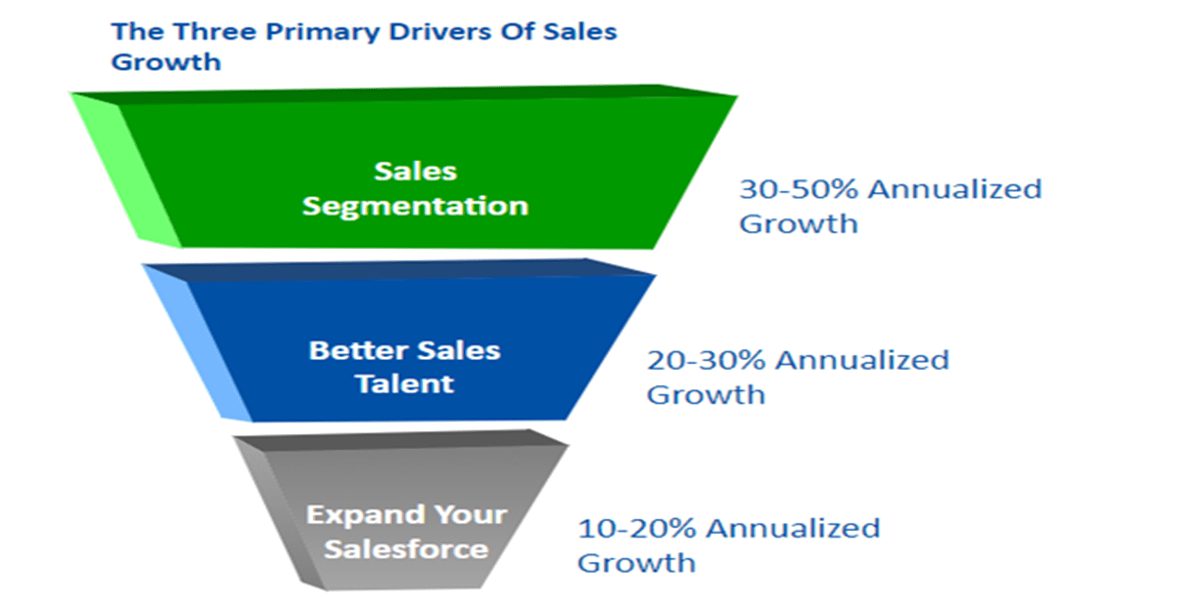For B2B companies, one of the best ways to accelerate sales growth is to develop a robust data-driven sales segmentation approach. This process uses a defined set of criteria and data to identify the prospects most likely to purchase your product or service. Typically, we see sales segmentation efforts use gut feelings or target broad segments the business thinks will buy their products/services. They then gather lists such as league tables of companies within those segments and leave it up to each salesperson to prioritize the names to call on. We have found that this approach is highly inefficient and not very effective.
Data-driven segmentation, on the other hand, dives much deeper – down to the individual company level, to determine who your sales team should focus on first. Every prospect is scored against every other prospect, giving your sales team the ability to prioritize their calling efforts. Our experience has demonstrated that sales can grow 30-50+% year on year by instituting this process.
So, why should you turn to the data for sales segmentation? Glad you asked because in this piece, we’re going to discuss:
- How data can help find your company’s sweet spot
- Why firms need data to increase growth
- Why the data-driven approach is so successful, and how it can make a difference at your company
Using Data (and your experience) to Identify Your Sweet Spot
Unlock the power of data to identify and prioritize prospects that are most likely to buy your product or service
 Using data can allow you to target prospects most likely to become customers.
Using data can allow you to target prospects most likely to become customers.
As we mentioned earlier, traditionally, sales segmentation involved guesswork, gut feelings, and broad generalizations. This model has worked in the past, but like many things, there is a better, more precise way to segment your prospects. To make the right decisions to meet your customers’ needs, and to reach even more potential buyers, you need to understand what makes a great customer for your business,
Having a good understanding of what a great client looks like will allow you to then target prospects that have many of the same attributes and who are most likely to buy your product or service. This is what data-driven sales segmentation is all about – finding your “sweet spot” so that your sales can flourish.
This process works by developing a list of targets and assigning them a score based on identifying and weighting specific client characteristics and using market data to calculate a score for every company in your target market. Using data to calculate this score permits you to create an unbiased, uniform approach to prioritizing all potential targets. This approach eliminates the guesswork and limited scope of traditional sales segmentation techniques.
Because each prospect is scored, you can readily see which potential customers should be prioritized by your sales team because based on your criteria, they have the highest likelihood of needing your product or service. This allows your sales team to target the highest scoring targets on your list, and immediately know that those are the best potential customers to start with.
Why Data is Necessary to Accelerate Your Sales Growth
What are the benefits of using a data-drive sales segmentation to increase growth?
 Tracking customer data can allow you to target and reach more potential customers.
Tracking customer data can allow you to target and reach more potential customers.
Using a data-driven approach to sales segmentation provides many benefits to B2B companies looking for a way to increase sales growth and revenues for the lowest cost:
- Increase your sales effectiveness. You want your sales segmentation to be effective at identifying new customers and increasing sales. By using a data-driven approach, you can expect to reduce cycle times, increase revenues, and profit. When you know exactly what firms might be interested in your product or service, you can target them and waste no time.
- Increases your sales efficiency. Companies are using data more and more to drive their decisions because they want to know precisely where they should concentrate their sales efforts. A data-driven sales segmentation gives your company an accurate prediction of which potential customers are most likely to buy your product or service. You will no longer have to waste time with dead ends, customers who aren’t that interested or worse, bringing on bad clients.
- All prospects are viewed consistently. The data doesn’t lie nor does it play favorites. When viewing the results of your sales segmentation, your company will develop a list of targets that have all been consistently scored based on the same factors and subjected to the same methodology. They are prioritized relative to each other and how likely each prospect is to need your business’ product or service.
- Includes individual prospects. Because the data-driven approach is sensitive to your company’s current capabilities, it allows you to target individual prospects based on your product/service offering.
- Highest growth, quickest, lowest cost. B2B firms typically have three drivers of sales revenues: sales segmentation, better sales talent, and expanding their sales force. Sales segmentation is by far the most effective and can yield 30-50+% in annualized sales growth. Given the relatively small amount of investment needed for this effort and how quickly it can be developed (in most cases less than 3 weeks), sales segmentation offers a much higher return on investment and can be implemented more quickly as compared to the other levers.
 Sales segmentation can lead your company to the most growth.
Sales segmentation can lead your company to the most growth.
Why is the Data-Driven Approach so Successful?
Using data takes sales segmentation and sales growth to the next level
Using data to drive sales segmentation is successful because it uses the real data both from your customers and the market to provide you with a list of prospects most likely to want your product or service. In the past target lists were developed using broad industry-level data, gut feelings, who you know, and a bias for/against certain prospects. This approach should be replaced with an analysis of detailed buying behaviors and client characteristics to match potential customers with your company’s current capabilities. Since data is used to prioritize your prospects, they can be accurately compared to each other and viewed through a common lens.
Simply making your net wide enough to find the right customer is highly inefficient. In fact, we believe that the net should be small if you know exactly where the fish are. Using data to drive sales segmentation allows companies to use a systematic and accurate methodology that can pinpoint their potential target customers based on very real factors and compile them into a target list that can be used by your sales team to focus on your highest priorities.
As you can see, data-drive sales segmentation allows your business to take an effective and targeted approach to identify potential customers. It can:
- Drive revenue and sales
- Get your sales force working on only the highest priority prospects
- Yields fast results and come with the highest return on investment
How Can Data-Driven Sales Segmentation Make a Difference for Your Company’s Growth?
Allow data-driven sales segmentation to increase your growth and revenues
Adopting an in-depth and analytical approach is the only way to flourish in today’s market–no matter what industry you’re in. Each business is different, which is why your data-driven sales segmentation criteria is customized according to your unique business capabilities. Drawing on the experience and knowledge of your sales team allows the process to quantify their deep understanding of the business and your customers.
The data-driven segmentation approach increases both the effectiveness and efficiency of your sales team. It allows them to concentrate their time only on high-priority prospects based on criteria established by the business. Data-driven sales segmentation uses your unique set of criteria/weighting and brings in detailed market data to provide you with a complete picture of your target audience. Scoring each prospect allows you to compare prospects relative to each other and prioritize them according to how likely they are to want your product or service. This is far more effective and efficient than the approach many B2B firms use today – performing basic, high-level sales segmentation and letting each salesperson prioritize their own list.
Using a data-driven approach to sales segmentation is crucial to ensuring your business has the information it needs to increase growth. Relying on the data to help make better decisions is the way forward and can offer your company a consistent and accurate way to increase sales growth and revenue.
If your business is interested in utilizing the tools of data-driven sales segmentation, Company Expert can help you plan, focus, manage the data, and get results.

